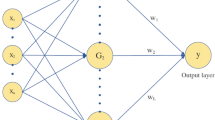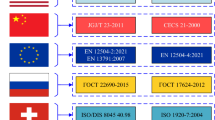Abstract
Current trends in modern research revolve around new technologies that can predict material properties without the expense of time, effort, and experimentation. Adapting machine learning methods to calculate various attributes of materials is receiving increasing attention. This study aims to forecast the 28-day compressive strength of high-performance concrete using both stand-alone and compound machine learning techniques. To this end, a stand-alone radial basis function and two ensemble optimizers, Gorilla Troops Optimization and Moth-Flame Optimization, have been applied. The R2 (coefficient of determination), RMSE (root mean absolute error), MAE (mean absolute error), SI (scatter index), and NRMSE (normalized root mean squared error) cross-validation were used to validate the performance of each model. In addition, the input parameters’ contribution to the outcomes’ forecast is specified by using a sensitivity analysis. All techniques used have proven to show improved performance in predicting results. The RBF–MFO model was the most accurate, with an R2 value of 0.996, compared to the RBF–GTO, with an R2 value of 0.987. Moreover, in the RBF–MFO index, RMSE = 0.937, NRMSE = 0.0149, MAE = 0.1875, and SI = 0.0149. On the other hand, for the combined RBF–GTO model, RMSE = 1.9588, NRMSE = 0.0304, MAE = 0.8111, and SI = 0.0304. Based on the data obtained, it is clear that the combined RBF–MFO model has achieved better performance.









Similar content being viewed by others
References
Abdollahzadeh B, SoleimanianGharehchopogh F, Mirjalili S (2021) Artificial gorilla troops optimizer: a new nature-inspired metaheuristic algorithm for global optimization problems. Int J Intell Syst 36(10):5887–5958
Abellán García J, Fernández Gómez J, Torres Castellanos N (2020) Properties prediction of environmentally friendly ultra-high-performance concrete using artificial neural networks. Eur J Environ Civ Eng 26(6):2319–2343
Akbari M, JafariDeligani V (2020) Data driven models for compressive strength prediction of concrete at high temperatures. Front Struct Civ Eng 14(2):311–321
Ali M, Kotb H, Aboras KM, Abbasy NH (2021) Design of cascaded PI-fractional order PID controller for improving the frequency response of hybrid microgrid system using gorilla troops optimizer. IEEE Access 9:150715–150732
AlOmar MK, Hameed MM, Al-Ansari N, AlSaadi MA (2020) Data-driven model for the prediction of total dissolved gas: robust artificial intelligence approach. Adv Civ Eng 1(1):1–20
Barham R, Sharieh A, Sleit A (2018) Moth Flame Optimization based on golden section search and its application for link prediction problem. Mod Appl Sci 13(1):10–27
Bors AG, Pitas I (1996) Median radial basis function neural network. IEEE Trans Neural Netw 7(6):1351–1364
Cauberg N, Pierard J, Remy O (2008) Ultra high performance concrete: mix design and practical applications. In: Walraven JC, Stoelhorst D (eds) Tailor made concrete structures: new solutions for our society. Taylor & Francis Group, London, vol 1, pp 1085–1087
Chatterjee AK (2011) Indian fly ashes: their characteristics and potential for mechanochemical activation for enhanced usability. J Mater Civ Eng 23(6):783–788
Chiew FH, Ng CK, Chai KC, Tay KM (2017) A fuzzy adaptive resonance theory-based model for mix proportion estimation of high-performance concrete. Comput Civ Infrastruct Eng 32(9):772–786
Chindaprasirt P, Jaturapitakkul C, Sinsiri T (2007) Effect of fly ash fineness on microstructure of blended cement paste. Constr Build Mater 21(7):1534–1541
Chou J-S, Tsai C-F, Pham A-D, Lu Y-H (2014) Machine learning in concrete strength simulations: multi-nation data analytics. Constr Build Mater 73:771–780. https://doi.org/10.1016/j.conbuildmat.2014.09.054
Coppola L, Coffetti D, Crotti E (2018) Plain and ultrafine fly ashes mortars for environmentally friendly construction materials. Sustainability 10(3):874
Ginidi A, Ghoneim SM, Elsayed A, El-Sehiemy R, Shaheen A, El-Fergany A (2021) Gorilla troops optimizer for electrically based single and double-diode models of solar photovoltaic systems. Sustainability 13(16):9459
Golafshani EM, Rahai A, Sebt MH (2015) Artificial neural network and genetic programming for predicting the bond strength of GFRP bars in concrete. Mater Struct 48(5):1581–1602
Hanehara S, Tomosawa F, Kobayakawa M, Hwang K (2001) Effects of water/powder ratio, mixing ratio of fly ash, and curing temperature on pozzolanic reaction of fly ash in cement paste. Cem Concr Res 31(1):31–39
Hola J, Schabowicz K (2005) Methodology of neural identification of strength of concrete. ACI Mater J 102(6):459
Iranmanesh A, Kaveh A (1999) Structural optimization by gradient-based neural networks. Int J Numer Methods Eng 46(2):297–311
Jain AK, Mao J, Mohiuddin KM (1996) Artificial neural networks: a tutorial. Computer (long Beach Calif) 29(3):31–44
Joseph S, Snellings R, Cizer Ö (2019) Activation of Portland cement blended with high volume of fly ash using Na2SO4. Cem Concr Compos 104:103417
Kaveh A, Iranmanesh A (1998) Comparative study of backpropagation and improved counterpropagation neural nets in structural analysis and optimization. Int J Sp Struct 13(4):177–185
Kaveh A, Raeissidehkordi M (2002) RBF and BP neural networks used for the design of domes. Sp Struct 5:469–478
Kaveh A, Servati H (2001) Design of double layer grids using backpropagation neural networks. Comput Struct 79(17):1561–1568
Khademi F, Jamal SM, Deshpande N, Londhe S (2016) Predicting strength of recycled aggregate concrete using artificial neural network, adaptive neuro-fuzzy inference system and multiple linear regression. Int J Sustain Built Environ 5(2):355–369
Khademi F, Akbari M, Jamal SM, Nikoo M (2017) Multiple linear regression, artificial neural network, and fuzzy logic prediction of 28 days compressive strength of concrete. Front Struct Civ Eng 11(1):90–99
Lam L, Wong Y, Poon C (1998) Effect of fly ash and silica fume on compressive and fracture behaviors of concrete. Cem Concr Res 28(2):271–283. https://doi.org/10.1016/S0008-8846(97)00269-X
Lam L, Wong YL, Poon CS (2000) Degree of hydration and gel/space ratio of high-volume fly ash/cement systems. Cem Concr Res 30(5):747–756
Leung CKY (2011) Concrete as a building material. Encycl Mater Sci Technol 1(1):1471–1479
Malhotra VM, Zhang M-H, Read PH, Ryell J (2000) Long-term mechanical properties and durability characteristics of high-strength/high-performance concrete incorporating supplementary cementing materials under outdoor exposure conditions. Mater J 97(5):518–525
Masoumi F, Najjar-Ghabel S, Safarzadeh A, Sadaghat B (2020) Automatic calibration of the groundwater simulation model with high parameter dimensionality using sequential uncertainty fitting approach. Water Supply 20(8):3487–3501. https://doi.org/10.2166/ws.2020.241
Mehta PK (2004) High-performance, high-volume fly ash concrete for sustainable development. In: Proceedings of the international workshop on sustainable development and concrete technology, pp 3–14
Mirjalili S (2015) Moth-Flame Optimization algorithm: a novel nature-inspired heuristic paradigm. Knowl-Based Syst 89:228–249
Neville A, Aitcin P-C (1998) High performance concrete—an overview. Mater Struct 31(2):111–117
Ni H-G, Wang J-Z (2000) Prediction of compressive strength of concrete by neural networks. Cem Concr Res 30(8):1245–1250. https://doi.org/10.1016/S0008-8846(00)00345-8
Pala M, Özbay E, Öztaş A, Yuce MI (2007) Appraisal of long-term effects of fly ash and silica fume on compressive strength of concrete by neural networks. Constr Build Mater 21(2):384–394. https://doi.org/10.1016/j.conbuildmat.2005.08.009
Pazouki G, Golafshani EM, Behnood A (2022) Predicting the compressive strength of self-compacting concrete containing Class F fly ash using metaheuristic radial basis function neural network. Struct Concr 23(2):1191–1213. https://doi.org/10.1002/suco.202000047
Sathawane SH, Vairagade VS, Kene KS (2013) Combine effect of rice husk ash and fly ash on concrete by 30% cement replacement. Procedia Eng 51:35–44
Sayed GI, Hassanien AE (2018) A hybrid SA-MFO algorithm for function optimization and engineering design problems. Complex Intell Syst 4(3):195–212
Shehab M, Abualigah L, Al Hamad H, Alabool H, Alshinwan M, Khasawneh AM (2020) Moth–flame optimization algorithm: variants and applications. Neural Comput Appl 32(14):9859–9884
Stellacci P, Liberti L, Notarnicola M, Bishop PL (2009) Valorization of coal fly ash by mechano-chemical activation: Part I. Enhancing adsorption capacity. Chem Eng J 149(1–3):11–18
Stoffel M, Gulakala R, Bamer F, Markert B (2020) Artificial neural networks in structural dynamics: a new modular radial basis function approach vs. convolutional and feedforward topologies. Comput Methods Appl Mech Eng 364:112989
Wetzel A, Middendorf B (2019) Influence of silica fume on properties of fresh and hardened ultra-high performance concrete based on alkali-activated slag. Cem Concr Compos 100:53–59
Yu J, Lu C, Leung CKY, Li G (2017) Mechanical properties of green structural concrete with ultrahigh-volume fly ash. Constr Build Mater 147:510–518
Yu Y, Li W, Li J, Nguyen TN (2018) A novel optimised self-learning method for compressive strength prediction of high performance concrete. Constr Build Mater 184:229–247
Zhu H, Wang Z, Xu J, Han Q (2019) Microporous structures and compressive strength of high-performance rubber concrete with internal curing agent. Constr Build Mater 215:128–134
Author information
Authors and Affiliations
Contributions
JZ: Writing—Original draft preparation. Conceptualization, Supervision, Project administration. TW: Conceptualization, Methodology, Software, Validation. JL Formal analysis, Software, Validation, Language review. LS: Software, Methodology, Writing—Original draft preparation, Language review.
Corresponding author
Ethics declarations
Conflict of interest
The authors declare no competing of interests.
Additional information
Publisher's Note
Springer Nature remains neutral with regard to jurisdictional claims in published maps and institutional affiliations.
Rights and permissions
Springer Nature or its licensor (e.g. a society or other partner) holds exclusive rights to this article under a publishing agreement with the author(s) or other rightsholder(s); author self-archiving of the accepted manuscript version of this article is solely governed by the terms of such publishing agreement and applicable law.
About this article
Cite this article
Zhao, J., Wu, T., Li, J. et al. Incorporation of radial basis function with Gorilla Troops Optimization and Moth-Flame Optimization to predict the compressive strength of high-performance concrete. Multiscale and Multidiscip. Model. Exp. and Des. 7, 69–82 (2024). https://doi.org/10.1007/s41939-023-00169-6
Received:
Accepted:
Published:
Issue Date:
DOI: https://doi.org/10.1007/s41939-023-00169-6




